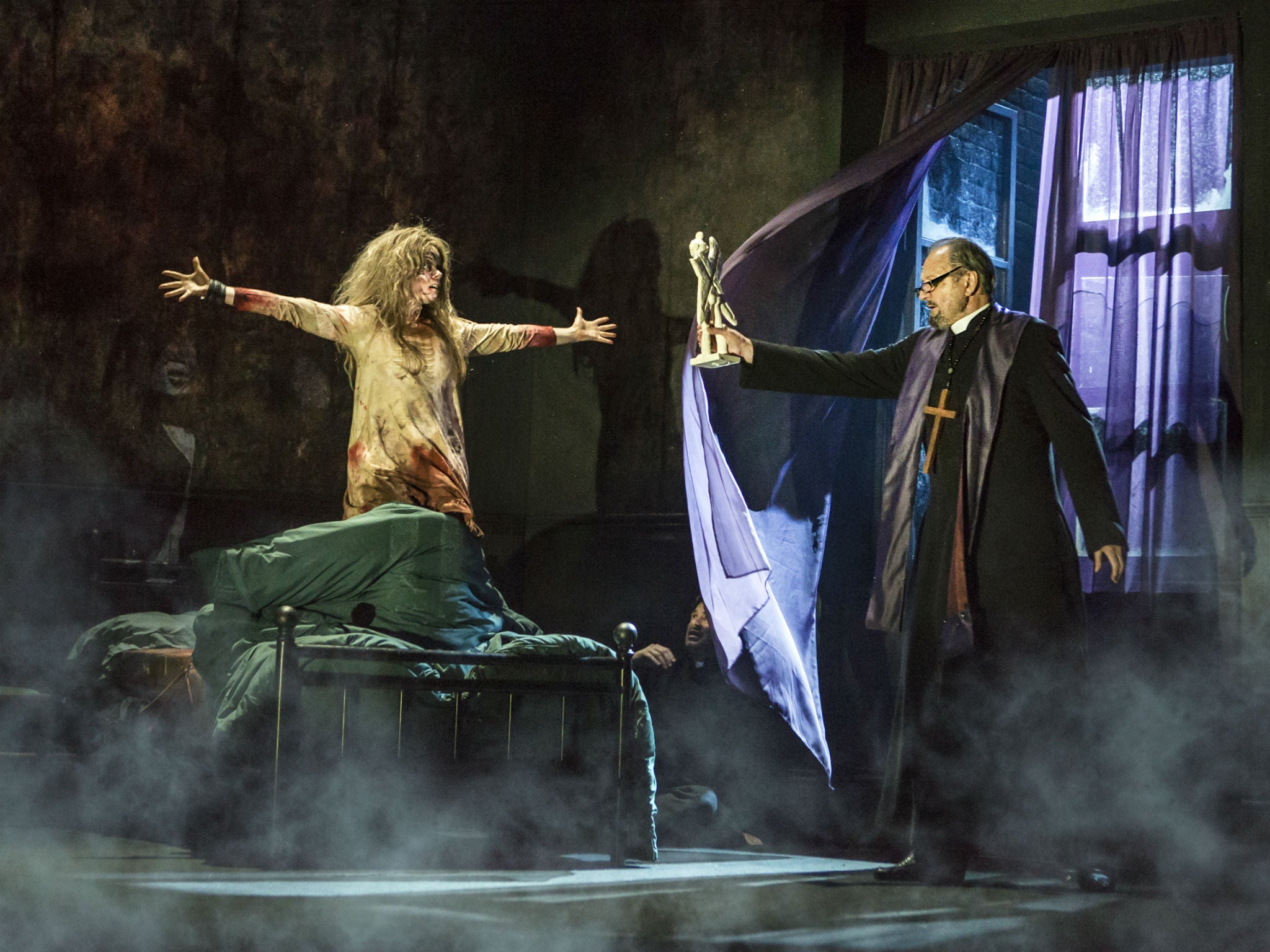The Exorcist, Phoenix Theatre, London, review: This show is less scary than the film but more profoundly disturbing
‘The Exorcist’ hits the West End stage 44 years after William Friedkin’s classic horror film about the demonic possession of a 12-year-old girl which caused audience members to faint

With its premiere timed to coincide with Halloween, The Exorcist hits the West End stage 44 years after the William Friedkin flick first frightened the hell out of cinema audiences and polarised critics. Hailed by some as a horror movie classic and trashed by others as “nothing more than a religious porn film”, it made diabolical amounts of money with its unnerving treatment of William Peter Blatty’s best-selling novel about the demonic possession of a 12-year-old girl in her Georgetown bedroom and her actress mother’s fight to reclaim her through an exorcism conducted by Catholic priests.
I should declare a (sort of) interest. This critic is of such a nervous disposition that I became a family joke when, watching The Sound of Music as a child, I screamed out on discovering that the nice messenger boy had become a Nazi. And, though long lapsed, I was brought up in the Catholic faith so it does not take much to trigger deep-ingrained terrors about the power of the (alleged) devil. But I never felt that my susceptibilities were being shallowly exploited by John Pielmeier’s intelligent (if imperfect) stage adaptation (which goes back to the novel) nor by Sean Mathias’s impressive production which – though it contains amusing elements (such as Tristram Wymarks gay, drink-soaked film director to whose grisly, head-turning demise we are made privy) – admirably resists the temptation to camp it up or to play its special effects for knowing laughter.
I mean it as a compliment when I say that this show is less scary than the film but that it’s perhaps more profoundly disturbing. It offers the pleasure of experiencing a story that you love-to-dread told in another medium that traps the audience in the same space as the characters and demands that the famous “moments” (the projectile vomiting, the swivelling head, the violently shaking bed et al) be conjured up live. Mathias has gathered a great technical team. Anna Fleischle’s shadowy, shuddery set shuts all the outside locations into one hermetic haunted house, with the awful cockpit of Regan’s room at its centre. Courtesy of the excellent, creepy projections designs of Jon Driscoll and Gemma Carrington, the wallpaper heaves and its pattern swarms like rats; ghastly images scud across cascades of infernal smoke. Ben Hart’s illusions cause drawers to fly through air, flickering lamps to explode, and the girl to almost slice her arm off.
These are not hammy, Hammer horrors, even if the thunderclaps become a bit predictable and repetitive in Adam Cork’s eerie soundscape with its tense heartbeat thud. My point is that the effects would operate on the nervous system only, if Mathias’s production didn’t make you feel that your whole moral being was being assaulted thanks to the brilliant killer combination of Clare Louise Connolly, the young adult actress who plays Regan, and Ian McKellen who voices the part of the demon. It sounded to me as though we had already reached the epicentre of obscenity in the early episode with the Ouija board in the attic when the hideously caressing and corrupt tones of this malevolent spirit wheedle their way into the girl’s soul by playing on her insecurities about her divorced, absent father and making seductive false promises.
This is a relatively low-key scene but you reckon that you are witnessing some primal, satanic act of child abuse. So Connolly’s astonishing performance horribly convinces you that the pre-pubescent poppet – bloodied from masturbating with a crucifix and then manacled to the bed – descends by blasphemous degrees into the depraved lip-syncing proxy of an evil that can’t be explained by medical science. It’s a shame that Peter Bowles is given too little time to develop the requisite intensity as Father Merrin, the archaeologist exorcist who digs up that dodgy amulet in the Middle East. The ending is rushed, too, and the role of the atheist mother who turns to priests in her desperate search for a solution, is somewhat sidelined by the actual exorcism, despite the persuasive presence of Jenny Seagrove. Adam Garcia, though, has room to give a finely conflicted account of Father Damien Karras, the psychiatrist priest who has lost his faith but winds up, in the climactic struggle, sacrificing his life to save the girl.
Karras is haunted by the death of the mother he neglected, black-and-white footage of whom slithers across the proceedings like a spooky, guilt-inducing rebuke from the afterlife. I’m reluctant to suggest that The Exorcist constitutes shameless propaganda for the Catholic Church even while saying that, for me, true horror resides in stories where the battle-lines between good and evil are more ambiguously drawn, as in, say, The Turn of the Screw. But this stage version of Blatty’s yarn insists, with unforgettable effectiveness, that the most destructive sin to which you can succumb is despair. I should like to apologise to all those Halloween revellers whom I scared by my jumpiness on the way home.
‘The Exorcist’, Phoenix Theatre, London, until 10 March 2018
Join our commenting forum
Join thought-provoking conversations, follow other Independent readers and see their replies
Comments